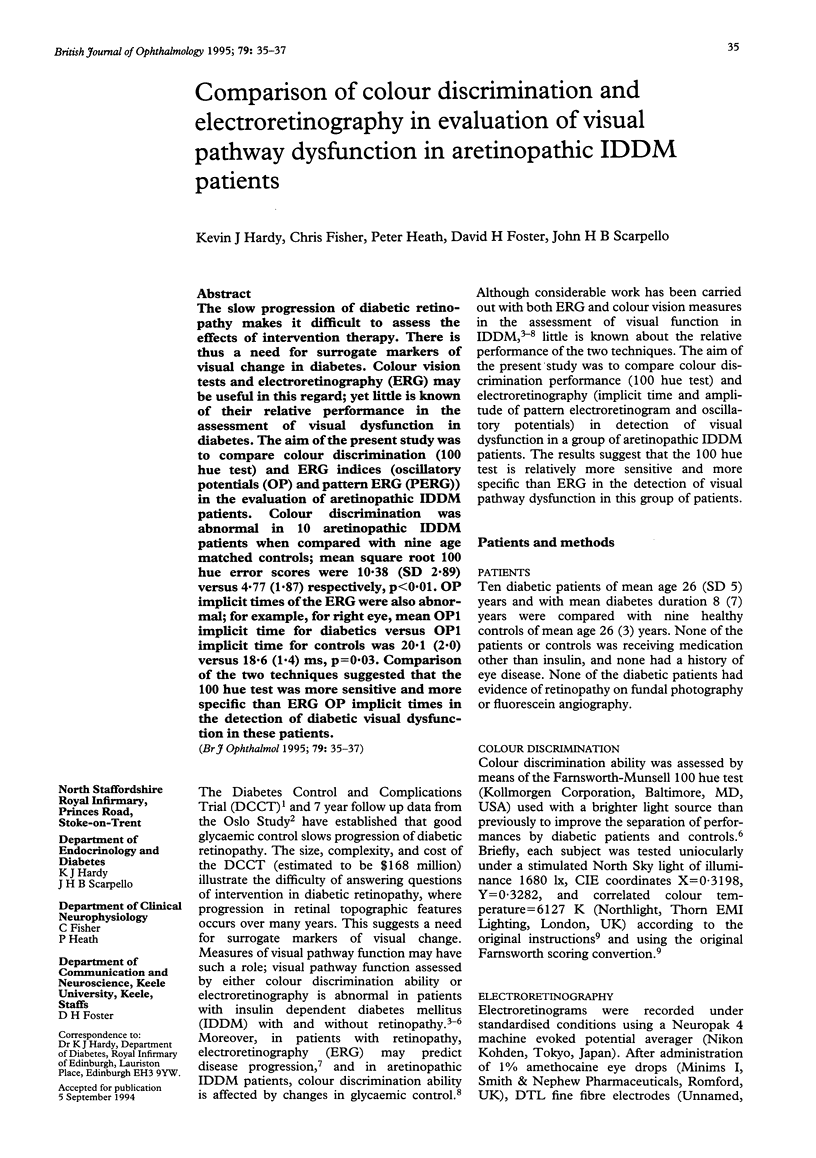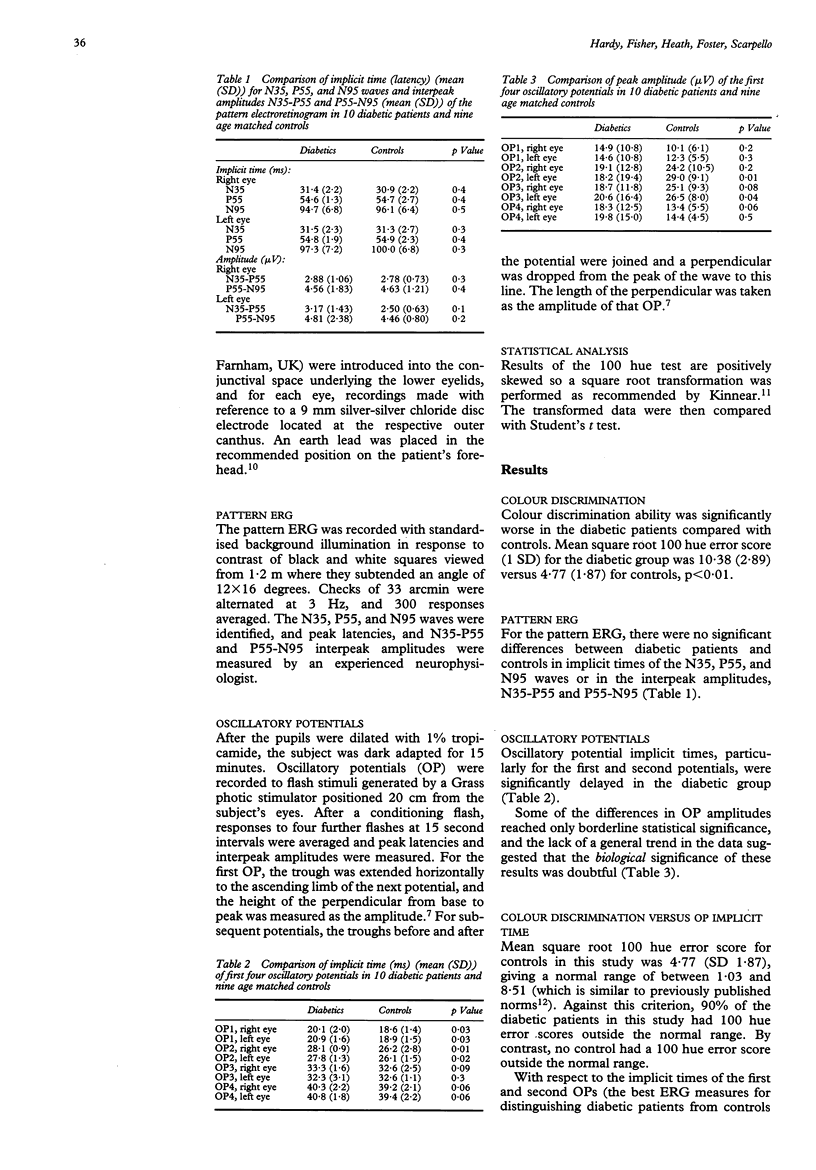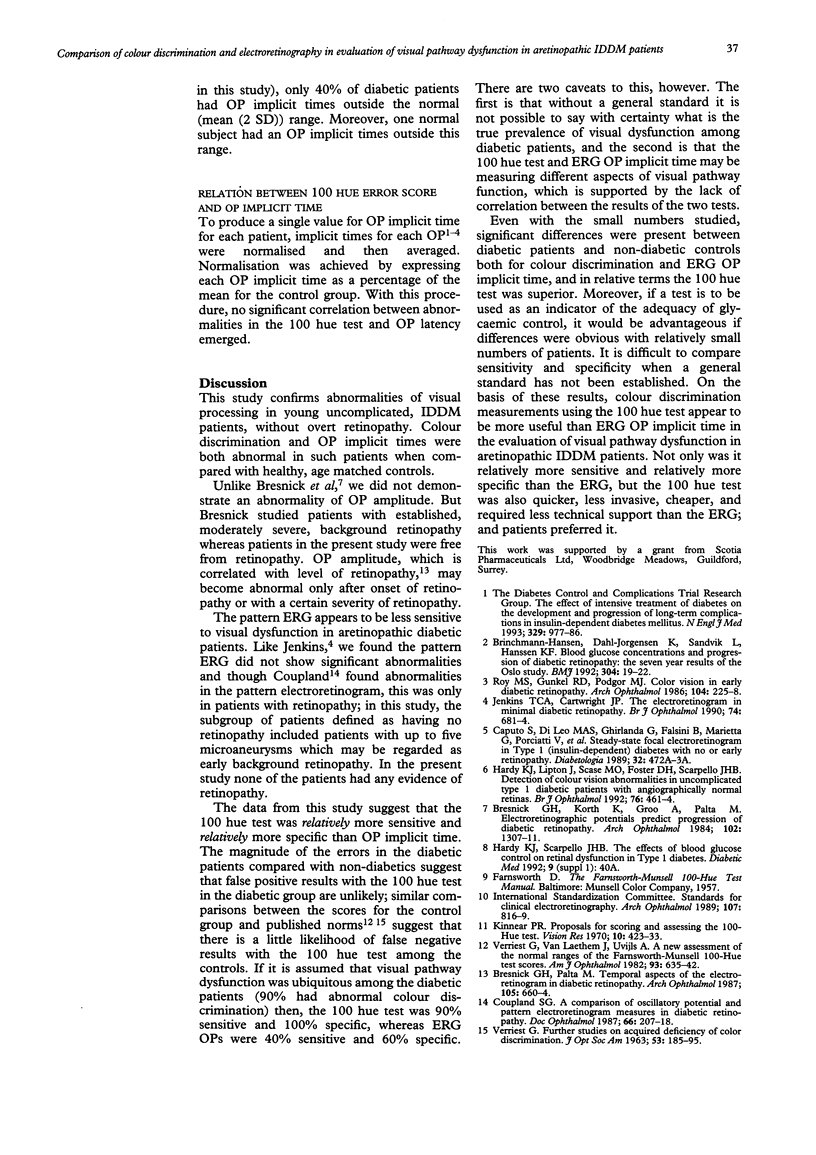Abstract
The slow progression of diabetic retinopathy makes it difficult to assess the effects of intervention therapy. There is thus a need for surrogate markers of visual change in diabetes. Colour vision tests and electroretinography (ERG) may be useful in this regard; yet little is known of their relative performance in the assessment of visual dysfunction in diabetes. The aim of the present study was to compare colour discrimination (100 hue test) and ERG indices (oscillatory potentials (OP) and pattern ERG (PERG)) in the evaluation of aretinopathic IDDM patients. Colour discrimination was abnormal in 10 aretinopathic IDDM patients when compared with nine age matched controls; mean square root 100 hue error scores were 10.38 (SD 2.89) versus 4.77 (1.87) respectively, p < 0.01. OP implicit times of the ERG were also abnormal; for example, for right eye, mean OP1 implicit time for diabetics versus OP1 implicit time for controls was 20.1 (2.0) versus 18.6 (1.4) ms, p = 0.03. Comparison of the two techniques suggested that the 100 hue test was more sensitive and more specific than ERG OP implicit times in the detection of diabetic visual dysfunction in these patients.
Full text
PDF


Selected References
These references are in PubMed. This may not be the complete list of references from this article.
- Bresnick G. H., Korth K., Groo A., Palta M. Electroretinographic oscillatory potentials predict progression of diabetic retinopathy. Preliminary report. Arch Ophthalmol. 1984 Sep;102(9):1307–1311. doi: 10.1001/archopht.1984.01040031057023. [DOI] [PubMed] [Google Scholar]
- Bresnick G. H., Palta M. Temporal aspects of the electroretinogram in diabetic retinopathy. Arch Ophthalmol. 1987 May;105(5):660–664. doi: 10.1001/archopht.1987.01060050078042. [DOI] [PubMed] [Google Scholar]
- Brinchmann-Hansen O., Dahl-Jørgensen K., Sandvik L., Hanssen K. F. Blood glucose concentrations and progression of diabetic retinopathy: the seven year results of the Oslo study. BMJ. 1992 Jan 4;304(6818):19–22. doi: 10.1136/bmj.304.6818.19. [DOI] [PMC free article] [PubMed] [Google Scholar]
- Coupland S. G. A comparison of oscillatory potential and pattern electroretinogram measures in diabetic retinopathy. Doc Ophthalmol. 1987 Jun;66(3):207–218. doi: 10.1007/BF00145234. [DOI] [PubMed] [Google Scholar]
- Hardy K. J., Lipton J., Scase M. O., Foster D. H., Scarpello J. H. Detection of colour vision abnormalities in uncomplicated type 1 diabetic patients with angiographically normal retinas. Br J Ophthalmol. 1992 Aug;76(8):461–464. doi: 10.1136/bjo.76.8.461. [DOI] [PMC free article] [PubMed] [Google Scholar]
- Jenkins T. C., Cartwright J. P. The electroretinogram in minimal diabetic retinopathy. Br J Ophthalmol. 1990 Nov;74(11):681–684. doi: 10.1136/bjo.74.11.681. [DOI] [PMC free article] [PubMed] [Google Scholar]
- Kinnear P. R. Proposals for scoring and assessing the 100-Hue test. Vision Res. 1970 May;10(5):423–433. doi: 10.1016/0042-6989(70)90123-9. [DOI] [PubMed] [Google Scholar]
- Roy M. S., Gunkel R. D., Podgor M. J. Color vision defects in early diabetic retinopathy. Arch Ophthalmol. 1986 Feb;104(2):225–228. doi: 10.1001/archopht.1986.01050140079024. [DOI] [PubMed] [Google Scholar]
- VERRIEST G. Further studies on acquired deficiency of color discrimination. J Opt Soc Am. 1963 Jan;53:185–195. doi: 10.1364/josa.53.000185. [DOI] [PubMed] [Google Scholar]
- Verriest G., Van Laethem J., Uvijls A. A new assessment of the normal ranges of the Farnsworth-Munsell 100-hue test scores. Am J Ophthalmol. 1982 May;93(5):635–642. doi: 10.1016/s0002-9394(14)77380-5. [DOI] [PubMed] [Google Scholar]


